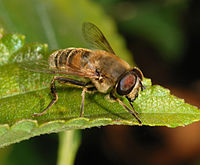
Photo from wikipedia
The protection and restoration of the biosphere is crucial for human resilience and well-being, but the scarcity of data on the status and distribution of biodiversity puts these efforts at… Click to show full abstract
The protection and restoration of the biosphere is crucial for human resilience and well-being, but the scarcity of data on the status and distribution of biodiversity puts these efforts at risk. DNA released into the environment by organisms, i.e., environmental DNA (eDNA), can be used to monitor biodiversity in a scalable manner if equipped with the appropriate tool. However, the collection of eDNA in terrestrial environments remains a challenge because of the many potential surfaces and sources that need to be surveyed and their limited accessibility. Here, we propose to survey biodiversity by sampling eDNA on the outer branches of tree canopies with an aerial robot. The drone combines a force-sensing cage with a haptic-based control strategy to establish and maintain contact with the upper surface of the branches. Surface eDNA is then collected using an adhesive surface integrated in the cage of the drone. We show that the drone can autonomously land on a variety of branches with stiffnesses between 1 and 103 newton/meter without prior knowledge of their structural stiffness and with robustness to linear and angular misalignments. Validation in the natural environment demonstrates that our method is successful in detecting animal species, including arthropods and vertebrates. Combining robotics with eDNA sampling from a variety of unreachable aboveground substrates can offer a solution for broad-scale monitoring of biodiversity. Description A drone incorporating a force-sensing cage with adhesive surfaces enables environmental DNA to be collected from tree branches.
Journal Title: Science Robotics
Year Published: 2023
Link to full text (if available)
Share on Social Media: Sign Up to like & get
recommendations!